
|
CHAPTER THREE |

Relatively few options are available in choosing the ground materials and
site conditions that must be accounted for in the design of highway projects.
The project must be constructed under the conditions that are present at the
particular site; minimal disturbance to existing elements of the roadway is also
a key control factor in the selection and design of the rehabilitation or
reconstruction scheme. For example, the widening of existing roadways or bridges
requires that the selected technique be one that can deal with the problem soil
condition effectively, and also cause minimal damage to the existing
facility.
This is especially true for roadway widening projects in areas
of very soft foundation soils. If the existing embankment was placed in an
excavated trench where the unsuitable material was removed, the same
construction technique will cause serious problems because excavation adjacent
to the existing embankment will jeopardize the stability of the existing
facility. In those cases where the foundation soil is not removed, the pressure
of the widened embankment causes significant differential settlements if the
soft soil is not reinforced or otherwise strengthened.
The problem of
economically constructing and maintaining stable slopes within limited
right-of-way is a continuing concern. Where increasing traffic requires the
addition of lanes within the same right-of-way, costly conventional earth
retaining structures are often necessary. Such structures are also required
where existing or proposed slopes are unstable and flattening of the slope is
not feasible.
In urban areas where depressed freeways are to be widened
or in rural areas where large cut slopes are to be reopened, the slope
excavation can become a very difficult and expensive engineering problem to
resolve. Innovative methods to stabilize or otherwise strengthen the existing
slope prior to excavation must be identified and evaluated to increase the
available inventory of design approaches that can be used to solve these
particular problems.
In recent years, some of the most noteworthy
advances in geotechnology have been in the area of earth reinforcement.
Powerful, innovative techniques have been initiated and are still being
developed here and abroad that have the potential for improving stability at
reasonable cost. However, it should be noted that throughout their short
history, commercial and technological innovations in ground improvement
technology have almost always preceded research studies of fundamental
performance and the development of engineering guidelines. Examples include:
reinforced earth, micro piles, tieback anchors, and soil nailing. Some of the
techniques under study were proprietary, and information on many of the
innovative methodologies was not widely distributed. Therefore, there was an
urgent need to collect, evaluate, and disseminate the current state of the art
on their use and applicability.
To encourage widespread use of these
systems, two pressing questions needed to be answered: (1) What new systems were
available? and (2) Where will they provide satisfactory performance at a cost
savings over conventional methods?
In the past, conservative thinking in
the highway field hindered innovative development and cross-fertilization of
special ground improvement techniques between the United States and foreign
countries, particularly western Europe and Japan. Innovations from these other
countries have fostered major changes in the United States in many areas of
ground improvement and earth retention systems. These changes have occurred in
both our approach to design and construction activities. They are good examples
of how foreign innovations have shaped U.S. practice.
![]()
3.1 Background
At the time this research project was initiated, hundreds of miles of
existing highways were scheduled to be reconstructed or upgraded in areas where
difficult soil and foundation conditions would be encountered. In many cases
there was considerable pressure applied to minimize the disruption to traffic
flow, and to select courses of action that did not require destruction of or
harmful effects to existing pavement systems or structural facilities such as
bridges and retaining walls that still had a long useful life
remaining.
Ground improvement techniques were found to provide benefits
in the following five major areas:
3.2 Objectives
The objectives were to identify and refine existing ground improvement techniques that can be used to stabilize or reinforce soil or rock masses that provide support for roads and structures. Design and construction guidelines were to be developed to reduce costs associated with providing adequate ground support for pavements, bridges, and retaining walls.
3.3 Scope
Research and development efforts in this project were directed toward
analyzing and improving existing techniques for reinforcing and strengthening
ground masses supporting or otherwise impacting highway facilities. The
development of new techniques to replace or supplement existing techniques was
also considered where appropriate. The utilization of ground improvement methods
for the design and construction of new highways was covered; however, the main
emphasis was on the bridge rehabilitation/replacement program and the roadway
restoration program.
This project included all materials and methods to
reinforce, stabilize, or otherwise improve soil and rock masses used to support
highway structures. The project evaluated the basic mechanisms underlying each
technique and developed rational design and construction methodologies for each
appropriate technique.
Design guidelines were developed for each
technique and included the selection of design values and the determination of
geotechnical design parameters, specifications and special provisions, and
system geometrics such as spacing, depth of treatment, equivalent diameters,
sizes, shapes, and weights. Other engineering considerations, such as effect of
groundwater table location, energy attenuation with depth, effective compaction
depth, and types of soils most suitable to each type of improvement technique,
were also studied and appropriate guidance was provided.
Construction
guidelines, including construction control and performance monitoring methods,
were also developed for each technique. Units of measurement and payment and end
product evaluation techniques were also developed and presented in a guidelines
format.
Although the main emphasis was on existing techniques rather than
developing new techniques, it should be noted that many of the existing
techniques evaluated were very new and still in their infancy in terms of
technical development and implementation. Some of these methods demonstrated
significant savings over conventional methods and showed great promise for even
larger cost savings when improved guidelines were developed under this
program.
3.4 Project Description
The major research efforts were in two tasks:
3.5 Soil Reinforcement
Inclusions have been utilized since prehistoric times for the improvement of
soil. The use of straw to improve the quality of adobe bricks dates back to
earliest human time, when many primitive people used sticks and branches for
reinforcement of mud dwellings. During the 17th and 18th centuries, French
settlers along the Bay of Fundy in Canada used sticks for reinforcement of mud
dikes. Some other early examples of man-made soil reinforcement include dikes of
earth and tree branches, which have been used in China for at least 1,000 years
and along the Mississippi River in the 1880's. Other examples include wood pegs
for erosion and landslide control in England, and bamboo or wire mesh, used
universally for revetment erosion control. Soil reinforcement can also be
achieved by plant roots.
Retaining walls are an essential element of
every highway design. Retaining structures are used not only for bridge
abutments and wing walls but also for slope stabilization and to minimize
right-of-way required for embankments. Not many years ago retaining walls were
almost exclusively made of reinforced concrete, and were designed as gravity or
cantilever walls. Such walls are essentially rigid structures and cannot
accommodate significant differential settlements. With increasing height of soil
to be retained and poor subsoil conditions, the cost of reinforced concrete
retaining walls increases rapidly.
Reinforced soil walls and slopes are
cost-effective soil retaining structures that can tolerate much larger
settlements than reinforced concrete walls. By placing tensile reinforcing
elements (inclusions) in the soil, the strength of the soil can be improved
significantly such that the vertical face of the soil/reinforcement system is
essentially self-supporting. Use of a facing system to prevent soil raveling
between the reinforcing elements allows very steep slopes and vertical walls to
be safely constructed. In some cases, the inclusions can also withstand bending
or shear stresses, thus providing additional stability to the system.
At
the time of this research, there were no uniform standards for these systems,
and in fact, there were different design and construction criteria and
procedures for each system. Moreover, each of these systems had a different
performance record. Research under this project identified and evaluated various
reinforcement methods such as tensile, compressive, and shear force resistance
elements that are inserted into the soil mass to improve bearing capacity and/or
settlement characteristics. The evaluations included all materials and methods
to reinforce soil masses. Studies were undertaken to evaluate the basic
mechanisms underlying each technique, and rational guidelines for design and
construction of each technique were developed. Each technique was evaluated by
reviewing the literature, and discussing the performance of particular case
history examples with design and construction engineers, plus specialty
contractors involved in using these innovative techniques.
Subsequent
studies involved soil characterization and reinforcement material evaluations to
determine appropriate parameters for design and construction control.
Small-scale laboratory model and also centrifuge model studies were conducted
for those techniques that required further refinement and verification.
Full-scale field testing and construction monitoring studies were also done to
validate some of the research findings from the initial investigations.
3.5.1 NCHRP Benchmark Study – The FHWA research program in soil reinforcement was based on the results of a major NCHRP study that performed an extensive literature review and evaluation of available systems and design methods (NCHRP Publication 290). That state-of-the-art report provided in-depth background on soil reinforcement for engineers seeking an understanding of this important, and at that time, new subject.
3.5.2 Reinforced Soil Structures – The NCHRP study was
expanded by FHWA to examine the design, construction, and performance aspects of
a selected few of the mechanically stabilized earth systems identified in Report
290 for use in retaining structures and excavation support systems. The main
purpose was to develop guidelines for these systems to provide highway engineers
with guidance for selection, design, and construction of the selected systems in
a generic manner.
The study was performed by reviewing and evaluating
several existing methods in terms of field experience, laboratory testing
(including centrifuge studies), analytical studies, and a full-scale field
evaluation program (figure 27). The results were then used to develop and
substantiate the generic design procedures and other guidelines presented in the
manual (32). Volume 2 contains a technical summary of the research supporting
theory to verify the design theory in Volume 1, plus information on several
proprietary reinforced soil systems (32).
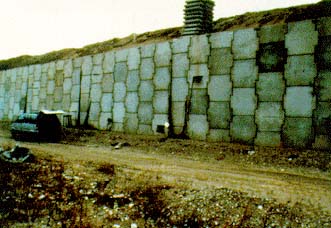
FIGURE 27. Reinforced soil test wall.
The manual has become a valuable tool to assist highway engineers and others in determining the feasibility of using reinforced soil systems for walls and embankment slopes on a specific project, evaluating different alternative reinforcement systems, and performing preliminary design of simple systems. The manual also provides a basis for evaluation and preliminary design of new earth reinforcement systems that may be proposed in the future.
3.5.3 Reinforced Soil Foundations (RSF) – A staff study at
TFHRC investigated the use of geosynthetic reinforcing elements beneath spread
footings to create a composite material with improved performance
characteristics to determine if this method of ground improvement is applicable
to bridge support. Information was obtained on how to quantify the improvements
and optimize the location of the reinforcement in the soil below the footing.
The results of this study proposed an optimal size of an RSF using soil strain
signatures and normalized settlement criteria. Model load test results on 34
footings describe the optimal depth and reinforcement layering within an
RSF.
One of the first tests conducted was on a spread footing placed at
the surface on an unreinforced compacted sand that was load tested to failure
(figure 28). Both the footing and surrounding soil were fully instrumented to
map the distribution of soil strain beneath the footing. The map was used to
describe the complete mode of soil failure, and clearly defines the zone of
maximum soil displacement. The identity of this zone within the engineered fill
pin pointed where the geogrid should be placed for optimum reinforcement in the
next series of tests.

FIGURE 28. Spread footing load test on reinforced soil foundation.
The next series of tests was conducted to evaluate the relationships between
the layering of the reinforcement to the width (B) of the spread footing. Two
series of load tests were performed on four different sizes of square footings
(0.3 m, 0.45 m, 0.6 m and 0.9 m) on the sand surface to measure the
settlement(s) of the footing at various loads.
The next tests were
performed to compare the performance of Reinforced Soil Foundations (RSF's) to
the unreinforced footings with various embedment depths (D) to determine the
best features of each approach to increase bearing capacity. For example, a
spread footing embedded 0.5 B was compared with a one-layer RSF placed at 0.375B
beneath the base of a surface footing. An embedded footing with a D/B of 1.0 was
compared with a three-layer RSF placed at 0.25B, 0.5B and 0.75B below the
surface footing. The test results were used to calculate bearing capacities at
various D/B ratios.
Vertical displacements within the sand below the
footings were measured by telltales located at various depths below the four
corners of each footing. Horizontal strains were measured by inclinometers
located at 0.25B and 1.0B outside the footing footprints. Linear Variable
Differential Transducers (LVDT's) were used to measure settlement at the top of
each footing for each load increment that was measured by load cells between the
footing and loading jacks. Footing settlement, vertical soil displacements below
the footing, and horizontal displacements to the side of each footing were
measured at each load increment.
As expected, the data show that soil
deformation occurs first in the upper layer of sand just below the footing and
propagates to deeper areas with increasing load, following a pattern that can be
clearly seen in any standard soil mechanics text. What is not shown anywhere
else besides these tests, is the well-defined strain signature that clearly
shows that almost all soil deformation occurs within a zone of 0.5B beneath the
footing, rather than 1.0 to 2.0B, as proposed by previous
researchers.
Because the data show that the upper layer undergoes the
highest strain during the early part of the load test, it is recommended to
place a layer of reinforcement in this zone of initial strain, and a second
layer in the lower zone of maximum strain. The telltale measurements clearly
identified the higher zone to be at 0.125B, and the maximum zone at 0.375B.
Placing a layer of reinforcement at these levels will significantly improve the
load settlement performance of surface or shallow depth footings on sand. If
only one layer is required, it should be placed at the point of maximum strain,
which is approximately at the 0.375B level. It was also noted that, when the
reinforcement was placed in the zone of maximum soil shear, it acted to
significantly inhibit the development of a classical bearing capacity
failure.
The zone of horizontal displacement is mostly within a distance
of 0.5B beyond the edge of the spread footing. This means that the reinforcement
doesn't need to extend more than 0.5B past the edge of the footing on all sides.
The imprint area of the reinforcement is therefore required to be four times the
size of the footing imprint.
In many tests comparing surface footings on
sand to surface footings on an RSF, the ultimate bearing capacity of the RSF was
twice the value of the conventional footing. The performance of an RSF was shown
to be very comparable to the positive effects of footing embedment. The
knowledge gained during these experiments was put to immediate use for design of
the RSF to support the geosynthetic reinforced soil bridge pier described in
section 3.5.4.1 of this chapter.
A review of the literature indicates
that this study was the largest of its kind, both in terms of number of footing
load tests performed and size of footings tested. The results clearly
demonstrate that geosynthetic reinforcement can substantially increase the
bearing capacity of shallow spread footings on sand and can reduce the amount of
settlement, especially differential settlement of the four corners of footings.
The footings resting on unreinforced sand settled unevenly, while those on
reinforced foundations settled very evenly with no tipping of the corners.
Additionally, the footings on a RSF were more likely to experience a gradual
failure curve rather than a plunging failure (30).
3.5.4 Geosynthetic Reinforced Soil Structures – The use of
geosynthetic grids and sheet materials to reinforce soil layers in walls,
abutments, and piers to support highway structures has increased significantly
in the 1990's due to cost advantages and freedom from worry about corrosion and
durability issues. Similar to the rapid increase of other ground improvement
technologies, expanded usage has preceded the development of rational technical
guidelines and fostered significant debate over several technical issues, such
as vertical spacing of reinforcement layers, connection issues, compaction
details, facing cracks, soil fill specifications, seismic response, scour
protection, pre-straining requirements, and optimal applications. It is also
necessary to determine optimum base to height ratios, including appropriate
limitations and design criteria, plus lateral load resistance
factors.
FHWA developed an in-house staff project to answer these
unanswered questions. The first phase of the study involved the construction of
a full-scale bridge support pier out of polymer based fabric sheets, road base
gravel, and regular home building cinder blocks (figure 29). The pier was
constructed at the TFHRC campus to facilitate construction supervision and
monitoring of the research testing. It was built on a reinforced soil foundation
platform that was placed approximately one meter below natural grade.
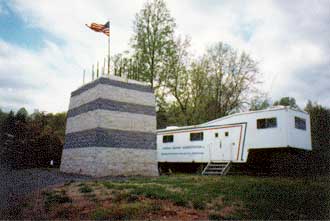
FIGURE 29. Geosynthetic reinforced soil support pier.
A series of model piers was also built and tested to supplement the results of the full-scale tests. These smaller piers were much faster to construct and easier to test to failure than the prototype, which permitted the researchers to vary different parameters to evaluate the effects of certain changes on overall performance. Another series of full-scale tests on the prototype and several larger full-scale structures is planned for the 1999 construction season.
3.5.4.1 Full-Scale Pier Project – The bridge support
pier was built to a height of 5.4 m and was 3.6 m x 4.8 m at its base, with a
slightly smaller top area due to an inward tapering effect for aesthetic
purposes. The pier was fully instrumented to monitor load, vertical settlement,
lateral deformation, and internal creep and strain in the reinforcing
fabric.
A thin concrete leveling pad was used beneath the facing blocks
to ensure a proper start and level rows of blocks throughout the entire height
of the pier. Six concrete reaction pads were placed on top of the support base
and inside the facing block perimeter. Four steel rods were anchored in each
reaction pad. They were designed to be extended through the full height of the
pier and attached to a similar set of six reaction pads to be placed at the top
of the pier and matched to the bottom pads. The steel rods were isolated from
the internal soil mass to preclude any vertical reinforcement contribution from
the rods. The reaction pads and connecting steel rods were needed to apply
squeezing loads for testing purposes, and were designed not to interfere with
normal functioning of the pier.
A high-strength, woven polypropylene
geosynthetic made by Amoco (#2044) was used to reinforce a well-graded gravel
material that is routinely used beneath highway pavements in Virginia. The
cinder blocks were dry stacked and served as a construction form as well as a
facing block for the gravel during compaction operations. The fabric was placed
at each layer of block and gravel, with no special connection features except to
overlap the fabric between each layer of blocks. No gluing or pinning was used
to secure the fabric to the blocks.
At the mid-height of construction,
the top reaction pads were placed and reaction beams were attached to the steel
rods to squeeze or pre-strain the composite soil mass using heavy duty loading
jacks. Load cells, LVDT's on top and on the sides, and a laser measurement
system were used to monitor stress and strain responses to the squeezing
process. The pre-straining operation served to eliminate most of the expected
post-construction settlements, and enhanced the composite nature of the
reinforced soil mass because the key to the composite feature is the denseness
of the soil and the bond connection between the fabric and the compacted
soil.
The vertical spacing between reinforcement sheets plays a major
role because the composite feature is greatly diminished when separation
distances between reinforcement layers become too large. The optimum spacing
issue was further studied under the model test investigation. The contribution
of the facing blocks is also under investigation. In addition to the facing
aesthetics, soil raveling and erosion control, and construction form work during
compaction, there is a good possibility that the blocks make a significant
contribution to the composite feature of the reinforced mass.
The size of
the reaction pads and the number of steel rods were far greater than necessary
to provide sufficient pre-straining during the construction process at the
mid-point (or one-third point if deemed appropriate) and completion of the
full-height pier. The extra reaction capacity was installed to provide
sufficient capacity for research load testing purposes. No rods or pads would be
needed if pre-straining was not considered important to ensure bearing capacity
and settlement control. For this design, only about half the available capacity
would have been required if load testing to failure was not in the plans, and
pre-straining only was desired.
At full-height construction, the pier was
again subjected to pre-straining. The same stress and strain type measurements
were taken, plus creep and strain measurements were made on four layers of
fabric installed in the top half of the pier. A total of 21 strain gauges was
installed on each of the four layers. The measured strain along each fabric
layer was uniform, indicating the load was applied evenly over the pier
area.
The pier was later load tested to a much higher level than the
pre-straining levels (but less than complete failure load) to determine near
upper bounds on bearing capacity and settlement values for this particular
composite mass. The loading was stopped when severe cracking, bulging, and
displacement of the facing blocks occurred, but not before load and displacement
measurements demonstrated how strong and capable this system is for support of
heavy bridge loads without significant deformations resulting. Maximum loading
conditions were not applied in order to preserve the structure for additional
testing; however, total collapse failure loads were imposed on the smaller scale
models discussed later.
The FHWA manual, Mechanically Stabilized Earth
Walls and Reinforced Soil Slopes Design and Construction Guidelines,
recommends that bridge loads on this type of structure not exceed 200 kPa (2.1
tsf). At this loading level the performance of the pier was very good. Lateral
deformation and vertical settlement were very small and no cracks or other signs
of distress occurred in the blocks. Performance also remained good at much
higher levels than the not to exceed limit specified in the manual.
The
connection strength issue did not seem to be a problem in this situation. The
connection consisted of a frictional bond between the blocks and the fabric,
with no glue or fasteners used to enhance the connection. Results show that none
was needed. The vertical squeezing forces that were applied to the soil and
fabric mass seemed to cause a "drag" type of force to be applied to the blocks
as the reinforced soil mass was forced to consolidate. Compression cracks
occurred as the drag forces reached higher levels; however, the connection issue
was not adversely affected.
The overall experiment was very successful
and served to increase our knowledge of how this type of structure can best be
utilized to provide safe and efficient support for highway bridges, especially
in remote areas where concrete and steel are expensive to haul to the bridge
site, and heavy equipment is hard to mobilize. This concept may also be a good
alternative in seismic areas because each layer of gravel and reinforcement may
serve as a force-dampening shock absorber between the earthquake-generated
ground motions and the bridge superstructure (33).
3.5.4.2 Model Studies – At another site on the TFHRC campus, a series of smaller scale models of the prototype pier were built and tested to failure. The same type of block was used to build the models except that the fabric was not placed to overlap the blocks, and the blocks were removed before testing. A base height ratio of 0.5 was used to provide similitude with the prototype. The same gravel material was used; however, the same geosynthetic reinforcement material was used in only a few of the models at various vertical spacing distances to investigate the effect of distance on the composite mass performance under extreme loads. A lesser strength fabric was also tested at varying spacing distances (33).
3.5.5 Corrosion and Durability – One of the major design
concerns for reinforced soil structures has been the corrosion or durability of
the reinforcing elements in the soil/water environment in which they are placed.
In the early days of building reinforced soil structures in the United States,
the material of choice was almost exclusively metallic, either in strip or grid
configuration. Galvanized steel worked best, and after a short trial period the
use of aluminum and stainless steel was discontinued due to very poor
performance. Concern about corrosion of the galvanized steel prompted some
engineers to try geosynthetic polymer materials as a reinforcement alternative;
however, similar durability concerns soon became apparent because of the lack of
information on degradation factors, such as hydrolysis and oxidation phenomena,
that might occur in the soil/air/water environment below ground.
To
assist engineers in designing new projects and evaluating existing walls, FHWA
performed a series of comprehensive research studies to investigate the
corrosion potential of metallic reinforcing elements and polymer degradation as
related to the design life of the reinforced soil structures. The durability
research included an analysis of the principal aging factors to determine the
extent of decomposition that typically occurs in a soil environment. Other
topics, such as installation damage, biological and environmental attacks, and
creep damage, were also investigated.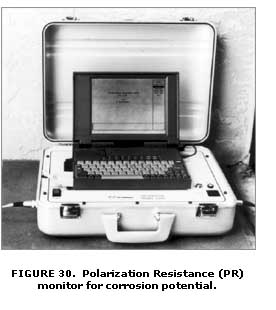 Two reports were
issued that describe the corrosion process and provide guidance and criteria for
evaluating potential corrosion losses when using coated or uncoated steel
reinforcing elements. Remote electrochemical measurement equipment called a PR
Monitor was also developed to monitor corrosion potential and in-situ corrosion
rates of base or galvanized steel reinforcements on both new construction or
existing walls. The PR Monitor (figure 30) measures the polarization resistance
(PR) of a corroding interface because the corrosion rate is inversely
proportional to the PR (34,35).
Two reports were
issued that describe the corrosion process and provide guidance and criteria for
evaluating potential corrosion losses when using coated or uncoated steel
reinforcing elements. Remote electrochemical measurement equipment called a PR
Monitor was also developed to monitor corrosion potential and in-situ corrosion
rates of base or galvanized steel reinforcements on both new construction or
existing walls. The PR Monitor (figure 30) measures the polarization resistance
(PR) of a corroding interface because the corrosion rate is inversely
proportional to the PR (34,35).
Several reports were also disseminated under the study, "Durability of
Geosynthetics for Highway Applications", that describe the hydrolytic and
oxidative degradation processes, installation damage patterns, and creep
concerns of polymer reinforcements. These reports, plus others in the publishing
process at the time of print for this summary report, provide guidelines and
testing protocols for calculating the appropriate strength reduction factors for
use in design life predictions (36,37,38). Some of the important findings are
discussed next.
On the basis of the data thus far, it appears that most
geosynthetic products have the durability needed for critical reinforcement
applications, especially in relatively neutral soil environments. In severe
environmental conditions, results indicate a fairly wide range of degradation
rates. A test protocol for long-term durability performance testing of
geosynthetics (i.e., oven aging and immersion testing) has been developed, along
with an analytical model for service life prediction of
geosynthetics.
Variations in the test protocols used to chemically
characterize polymers, with specific reference to geosynthetics, which could
significantly affect test results or make test results difficult to interpret,
have been identified and corrections to the protocols were made. These protocol
variations help to explain why comparison and use of data provided in the
literature are difficult.
From the effort to better define the testing
protocols, preliminary standardized test and QC/QA procedures to be applied
industry-wide have been developed. This has set into motion the ability of the
industry to perform the tests that will likely be recommended for future
evaluation of geosynthetic durability, and the ability to develop a consensus on
how those tests should be performed and quality control maintained.
The
polymer and soil environmental factors that affect the geosynthetic degradation
rate have been identified as well as tests that can be used to assess and
quantify these factors. The study has also identified the issues that must be
addressed to develop life prediction models for geosynthetics, especially with
regard to relating the laboratory environment to the in-soil environment. A
technology transfer report was developed by FHWA's Office of Technology
Applications to assist practitioners in implementing the new guidelines
(39).
A separate but parallel effort by Transportation Research Board
(TRB) committee A2K07 has been initiated to develop the framework necessary for
rapid implementation of the results of this study. This effort has also helped
to identify just where the real needs in terms of geosynthetic durability
knowledge are so that a coherent recommended practice to determine the long-term
strength of geosynthetics can be developed.
The study has created an
environment that has promoted improved communications within the industry, in
particular their polymer experts and suppliers, and with the portion of the
engineering community that routinely uses geosynthetics. This has allowed the
geosynthetic industry to better understand the needs of those who use
geosynthetics regarding durability issues, and has helped geosynthetic users to
know what questions to ask and what can be realistically expected from the
industry. A team spirit between the industry and geosynthetic users, which was
not present before the study began, has begun to develop.
3.5.6 Permanent Ground Anchors (Tiebacks) – Permanent
ground anchored wall systems, often called tieback walls, use tensile elements
anchored in the ground to support earth retaining structures or stabilize
landslides. These walls are built in excavated cuts from the top down. Other
highway applications include bridge abutment underpinning when an end slope
under an existing bridge is removed to permit widening of the roadway; and the
strengthening of existing earth retention structures that have deteriorated
because of corrosion or require additional support for increased loading
situations.
Temporary ground anchors were the first system to be
introduced in the United States to support excavations while the permanent
facility was being constructed. Soon, however, these temporary measures gained
wide acceptance because of economic and safety aspects, and they gradually
became attractive as permanent solutions. The economy results from elimination
of temporary support systems and reduced right-of-way considerations; safety is
improved by eliminating cramped excavation work areas that are cluttered with
delicate bracing.
Permanent ground anchors are relatively new
geotechnical elements that were developed to a large extent by specialty
contractors who had developed their own methods of design and installation. Many
of these methods were proprietary or closely guarded family secrets. SHA design
provisions were viewed by ground anchor contractors as unnecessarily
conservative and restrictive, which increases construction costs.
At
first there was much concern on the part of highway engineers because of a
perceived lack of rational design procedures, construction methods, and
documented performance experience. In response to this need, FHWA researchers
initiated a contract research study to investigate this technology under
experimental conditions to examine stresses and deformations occurring under
typical loading conditions. Results were then used to develop a comprehensive
manual of engineering guidelines and a computerized design procedure
(40).
A series of four model test walls (2 m high and 5 m wide) were
instrumented and tested to failure (figure 31) at the University of Illinois to
verify and refine the preliminary guidelines established in the early stages of
the study on the basis of a literature search and analytical trials. A
full-scale wall (10 m high and 60 m long) was also built to further refine and
validate the new guidelines. The full-scale wall (figure 32) was built at the
NGES facility at Texas A&M University. One section of the wall had only one
row of anchors with heavy soldier beams, and the other had two rows of anchors
with smaller soldier beams. Pullout tests of full-scale, vertically installed
ground anchors were also conducted in an adjacent area at the TAMU clay site
(41).
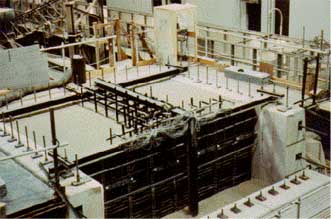
FIGURE 31. Large model ground anchor test wall.
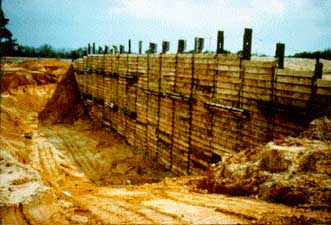
FIGURE 32. Full-scale ground anchor test wall at TAMU NGES.
3.5.7 Soil Nailing – Soil nailing is an earth retention
system that combines short in-situ reinforcements and shotcrete to support
excavations, hillside cuts, depressed cuts, and embankment steepening. Soil
nailing structures are built from the top down in a minimum of space, without
temporary support, without soldier beams, without disruption behind the wall,
and less disruption to traffic and adjacent construction activities. Soil
nailing structures can be built in cohesive and granular soils or in relatively
heterogeneous soils with small, easily mobilized equipment, with less start-up
time, and in remote sites. Soil nailing walls are often the most effective
solution to the problems associated with emergency repairs, vertical cuts close
to property lines, projects where drilling costs are high, and projects with
limited access. When used in the proper application, a soil nail wall can be
constructed faster and more economically than most other retaining wall
systems.
An in-situ reinforcement technique that improves the soil's
overall stability, soil nailing is constructed with steel reinforcing bars (soil
nails) that are usually drilled and grouted into the ground. Sometimes, other
metal tubes or rods are used instead of bars to resist tensile, compressive, and
shear stresses. A relatively large number of soil nails are installed in a
designed pattern that reinforces the earth into a stable block, which supports
the unreinforced soil behind it in a way that is similar to that of a gravity
wall. Soil nailing structures are designed to be both externally and internally
stable. External stability requires that the structural mass be designed with an
adequate factor of safety against sliding, overturning, and bearing
failures.
To check a structure's internal stability, most engineers use a
method of limit equilibrium analysis that computes the driving and resisting
forces at the critical failure surface. To further the development and use of
soil nailing, FHWA has instrumented many soil nailing structures, conducted
extensive model testing, and thoroughly analyzed prototype walls. As a result,
current designs are more economical and provide for better control of
movement.
Construction of a vertical excavation begins with a shallow
cut. The height of this cut is determined by the soil's ability to temporarily
stand unsupported, normally about 2 m. The next step consists of
shotcreting the cut and installing the soil nails. Once these steps are
completed, another lift is constructed below the first, and the process is
repeated until the desired level is reached. Drainage is provided to remove
water from behind the shotcrete wall. When soil nailing projects are constructed
as retaining walls, construction follows the same sequence, with the addition of
better drainage details and possibly corrosion protection for the
nails.
In nonaggressive ground environments, grout alone provides
satisfactory corrosion protection. When used in more aggressive soils, the steel
nail can be epoxy coated to increase its resistance to corrosion. In most soil
nailing applications, the construction of a separate concrete face is reasonably
economical, as well as aesthetically and structurally superior to the use of
shotcrete facing.
Although soil nailing was imported to the United States
from Europe with reasonably good engineering guidelines, there were some major
questions concerning the general behavior mechanisms, failure modes, durability
aspects, facing design, and seismic behavior. A series of research studies was
initiated to develop comprehensive technical guidelines for using soil nailing
techniques to stabilize highway slopes and excavations. The development of a
computerized design program was also an important associated objective of this
research.
Analytical studies and physical experiments were conducted to
evaluate design parameters such as type of soil and noncompetent rock suitable
for nailed reinforcement; type, size, and location of reinforcing nails; and
design equations for checking stability, internal pullout resistance, and
deformations. Durability aspects were also to be identified and procedures
developed to provide assurances for corrosion protection and structural
permanence. Laboratory tests were conducted to verify the choice of appropriate
parameters for prediction and design. Field tests were then performed on
full-scale structures to verify laboratory and analytical results (42). Figure
33 shows an instrumented nail being installed on a test wall at the Cumberland
Gap tunnel project.
During the course of the soil nailing research
project, a partnership with French researchers was developed to coordinate
investigative efforts. The cooperative project was called "Clouterre", which is
French for "soil nail." As part of the Clouterre agreement, FHWA agreed to focus
major efforts on seismic behavior, field performance monitoring, development of
a research quality data base, and facing design investigations. France placed
most of its emphasis on the analysis of the engineering behavior of soil-nailed
structures in different types of soils, including system behavior and structural
displacements. The French researchers were also responsible for making a
critical assessment of available design methods and special loading conditions,
such as frost effects and surcharge loadings, that occur at bridge
abutments.
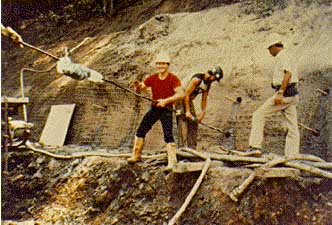
FIGURE 33. Installation of instrumented soil nail at Cumberland Gap site.
A study entitled "Seismic Analysis of Soil-Nailed Retaining Structures" was
initiated under joint sponsorship with the National Science Foundation (NSF) to
evaluate the response and possible failure mechanisms of soil-nailed walls under
dynamic loads. A finite element analysis and evaluation of the dynamic loading
behavior of these walls was performed using an integral approach consisting of
post-earthquake observations, centrifuge testing, and numerical analysis. The
researchers developed testing procedures to establish reliable design parameters
for characterizing the dynamic soil-nail interaction and formulated an analysis
procedure for the computation of dynamic loading effects on the location and
magnitude of maximum nail forces.
A series of laboratory model tests and
full-scale field tests was previously completed for FHWA to evaluate soil and
reinforcement parameters that are involved in the design and construction
procedures for soil nailing. Data analysis and evaluation of existing procedures
were used to develop interim design and construction guidelines for using soil
nailing techniques to stabilize soil cutslopes.
In a separate research
study, FHWA funded a project for "Testing of Soil Nail Wall Facings" to
determine ultimate and service capacities for developing an appropriate
facing/connection design, especially in regions of high seismic activity. At the
time of this research, the design methods for facings were quite conservative.
Therefore, it was hoped that this research would allow thinner facings to be
used, resulting in construction cost savings. Also at that time, there was not a
consensus regarding which of the available design methods should be used,
because none of the methods were found to directly apply to soil nail wall
facings. The new procedures are described in the FHWA manual
(43).
Another FHWA study investigated the use of soil nails for cohesive
soil stabilization. A specialized direct shear apparatus was used to test
specimens of the clay reinforced with small-diameter steel bars (nails) to
examine the engineering effectiveness of using soil nails to stabilize
excavations and slopes in clay soils. Proof tests were conducted initially using
sand to verify the performance of the shear test apparatus, measurement
instrumentation, and data acquisition system. Direct shear tests were then
performed on unreinforced clay specimens to obtain reference data under constant
strain rate loadings before the soil-nail reinforced tests were done. Stresses
in the nails during soil shearing were measured to determine the nature of nail
loading. Existing stability analysis methods for nail reinforced soil masses
were verified and modified to account for the measured behavior.
A
full-scale wall was constructed at the UMASS NGES facility in Amherst within the
varved clay layers of soil in a remote section of the site. Two rows of nails
were installed and readings were taken from the strain gauges and tip load cells
on the nails, plus the vertical and horizontal inclinometers and piezometers in
the soil behind the wall face. The wall was then induced to fail (figure 34) by
excavating below the reinforced portion of the wall to undercut its stability.
Instrumentation readings were taken during the excavation operations, and at
failure when the wall was undercut a total of 2.5 m below the reinforced face of
the wall. The field work was funded by FHWA and ADSC.
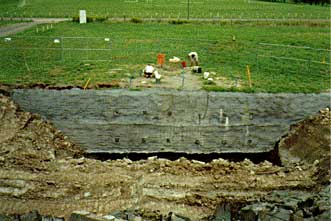
FIGURE 34. Failed soil nail wall due to undercutting.
FHWA and the Washington State Department of Transportation cooperatively funded a study to collect and develop a world-wide data base of instrumented soil nail wall projects. The study also involved using the data base to evaluate existing soil nailing design methods. The data collection and evaluation/validation of the available limit-equilibrium methods provided an improved understanding of the stress-deformation mechanisms in soil-nailed walls, which in turn led to the development of an improved and well-substantiated design procedure for soil-nailed walls.
3.6 Soil Treatment
The primary concern in soil support for structures is volume stability,
strength and durability. However, adequate support is highly variable and is
more case specific than site specific. In the proper state, virtually any soil
type, except highly organic materials, may be adequate for foundation support.
Conversely, any soil type, in its natural state, may be inadequate for
foundation support. Adequate soil support depends more on the loadings and
performance requirements than it does on the soil itself.
The history of
soil treatment techniques can also be traced back to ancient times, like
reinforcement technology. During the 1970's and 1980's, several promising
technologies were imported from Europe along with the previously described
reinforcement methods, except that they did not require the insertion of
reinforcing elements into the soil mass. Four of these special methods were
selected by FHWA for detailed study and evaluation to better understand the
basic mechanisms underlying each technique; however, subsequent funding
limitations caused the elimination of one of these technologies (grouting) from
the overall program. Research studies were initiated and completed on dynamic
compaction, prefabricated vertical drains, and stone columns.
3.6.1 Stone Columns – As in most new ground improvement techniques that were developed in foreign countries, experience has preceded the development of theory and comprehensive guidelines. Stone columns have been used since the 1950's as a technique for improving both cohesive soils and silty sands. Potential applications include (1) stabilizing foundation soils, (2) supporting structures, (3) landslide stabilization, and (4) reducing liquefaction potential of clean sands. The high potential for beneficial use in highway applications prompted a comprehensive investigation to determine how and why the system works so well, and to develop appropriate design and construction guidelines. The guidelines report describes construction, field inspection, and design aspects of stone columns. Also, several case histories are described. Bearing capacity, settlement, and stability design examples are given in the design appendices (44).
3.6.2 Dynamic Compaction – Dynamic compaction is also a
very cost-effective soil treatment technique that can be used to improve poor
subgrade support conditions at a roadway or bridge site. This is particularly
true in or near urban areas where land with good support conditions has already
been developed or set aside for commercial purposes other than highways. Much of
the remaining space is undeveloped land because of poor soil
conditions.
In many cases new roads and streets are forced to traverse
old landfill deposits, strip mine spoil areas, or building rubble and
construction debris deposits. Naturally occurring loose sands and collapsible
soils such as loess can also present difficult construction problems for highway
engineers. Dynamic compaction techniques have proven to be ideally suited to
handle these problems where other techniques have failed. Another important
application is for densifying loose sands to reduce liquefaction potential in
high-risk seismic zones. Dynamic compaction techniques have been found to
produce densification in natural and manmade deposits to depths varying from 3
to 12 m below grade.
Dynamic compaction is defined as the densification
of loose soil deposits or miscellaneous fill materials by means of repeatedly
raising and dropping a heavy weight from varying heights to impact the ground
(figure 35). This process has also been called by other names, including impact
densification, heavy tamping, dynamic consolidation, pounding, and dynamic
precompression. The energy is generally applied in phases on a grid pattern over
the entire loose or soft area using either single or multiple passes. Following
each pass the craters are either leveled with a dozer or filled with granular
fill material before the next pass of energy is applied.
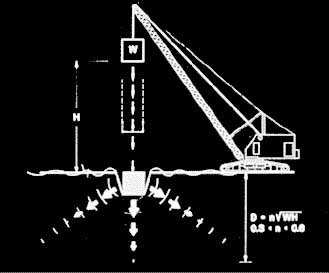
FIGURE 35. Schematic of dynamic compaction methodology.
All of the energy is applied from existing grade, and the degree of
improvement is a function of the energy applied through the mass of the tamper,
the drop height, the grid spacing, and the number of drops at each grid
location. Lighter tampers and smaller drop heights result in shallower
improvements. For greater depths and higher relative density improvements,
heavier tampers and higher drop heights must be used.
When the technology
was first imported from Europe, little was known about how to plan a project or
complete a preliminary evaluation to determine if dynamic compaction is
appropriate for the specific site and subsurface conditions. Design details and
construction monitoring guidelines were nonexistent. There were no sample
specifications to guide designers, and no procedures were available to measure
the degree of improvement achieved with each pass. Not knowing when enough is
enough can reduce the cost advantages rather quickly.
To gain more
insight, FHWA initiated a contract research study to conduct tests and
evaluation studies of the improvement mechanism to better understand how the
technique worked. A series of field experiments was conducted to investigate
soil and tamping parameters involved in the dynamic compaction process.
Instrumentation was installed to monitor ground vibrations, horizontal and
vertical displacements, pore pressures, acceleration and speed of the tamping
weight, penetration of the weight into the ground, and degree of treatment
achieved.
The results of the field tests were used to develop generic
specifications and a manual that describes in detail all of the design and
construction issues, plus all of the non-technical issues previously mentioned
(45). The manual was recently updated by FHWA's Office of Technology
Applications and reissued as Geotechnical Engineering Circular No. 1 to provide
this new information to assist SHA's with a user-friendly engineering document.
A slide tape show was also developed to provide a visual rendering of the manual
for instructional purposes.
3.6.3 Prefabricated Vertical Drains – The need for proper
drainage in highway projects is well established. Sand and /or gravel layers (or
other geometric shapes) have been used for decades to provide the appropriate
drainage vehicle. One of the most cost-effective methods of soft ground
improvement is through drainage, especially the use of radial drainage and
manmade vertical drains working in tandem. When heavy embankments are placed on
soft depositional type soils, the loading will tend to squeeze the water out of
the soil in a vertical upward direction to a drainage blanket placed at the
bottom of the embankment, and possibly downward to a natural drainage layer (of
sand) that might exist below the soft and low permeability layer that is being
squeezed.
In a soil that has been deposited in layers in ancient times,
the boundaries between layers tend to impede the water flow vertically.
Therefore, the horizontal permeability is significantly faster, and can be as
much as 10 times faster if there are intermittent granular layers in the
deposited soil. By installing artificial vertical drains, the drainage path is
greatly reduced and horizontal permeability will control the time of
drainage.
When water is drained, the soil consolidates and gains
strength, which increases its ability to safely carry more embankment loading,
which will cause more consolidation and so forth. Very high embankments can thus
be constructed in stages with time delays to allow for consolidation and
strength gain.
Until recently, sand drains have traditionally been used
for this purpose with success; there are, however, a number of practical
constraints associated with installing sand drains, namely, the disturbance of
soil (smear) around the sand drain, the need for a large quantity of water when
jetting is used, the availability of quality sand to fill the drains, and the
relatively high cost of installation.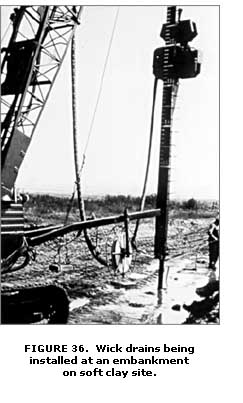 Because of these
disadvantages, engineers searched for a better way to create these artificial
drainage paths that would be cheaper, faster, and environmentally less
disruptive. The most popular alternative was called a "wick drain" and consisted
of a prefabricated plastic band that had a geosynthetic filter fabric wrapped
around a central plastic core that the water moved through after it was filtered
through the wrapping (figure 36). Although these wick drains had many
significant advantages over sand drains, there were many unanswered questions
regarding design assumptions, laboratory screening tests, quality control,
installation methods, durability, and generic acceptance specifications.
Because of these
disadvantages, engineers searched for a better way to create these artificial
drainage paths that would be cheaper, faster, and environmentally less
disruptive. The most popular alternative was called a "wick drain" and consisted
of a prefabricated plastic band that had a geosynthetic filter fabric wrapped
around a central plastic core that the water moved through after it was filtered
through the wrapping (figure 36). Although these wick drains had many
significant advantages over sand drains, there were many unanswered questions
regarding design assumptions, laboratory screening tests, quality control,
installation methods, durability, and generic acceptance specifications.
Recognizing the huge potential of prefabricated vertical drains, industry
responded with the development of a large number of different and mostly
proprietary models; some good, others not so good. Engineers soon discovered the
need for generic testing protocols to help them select and approve satisfactory
drains.
A comprehensive FHWA research study was initiated to develop
generic testing procedures and sample specifications, as well as complete
descriptions and helpful guidance for design and construction. The study also
included a parallel investigation of prefabricated drainage sheets and boards
that were becoming popular for use behind retaining walls.
For more
detailed descriptions of types and physical characteristics of these drainage
materials, the best source is FHWA-RD-86-169 for wick drains, and FHWA-RD-86-171
for sheet drains (46,47). These reports also provide a discussion of design
considerations, recommended design procedures, guideline specifications, and
advice on construction installation, control, and performance evaluation.
3.7 Publications and Implementation Items
Research and development activities for ground improvement techniques were very successful. Numerous quality reports and manuals were generated from this project, which is by far the most comprehensive research investigation of this topic by any single organization in the world. Numerous technology transfer items were disseminated to accelerate the implementation of this new information to highway practitioners. Many changes were made to the AASHTO Specifications (see chapter 7) and several FHWA training courses and technical circulars were developed on the basis of the research results.